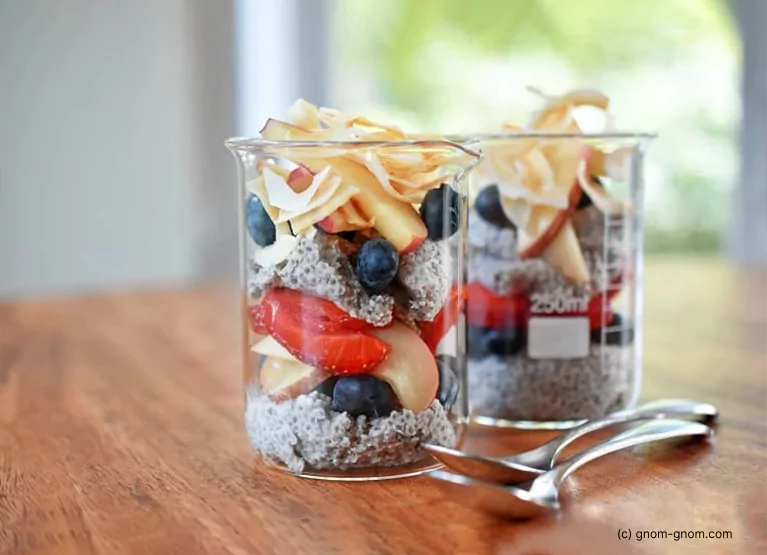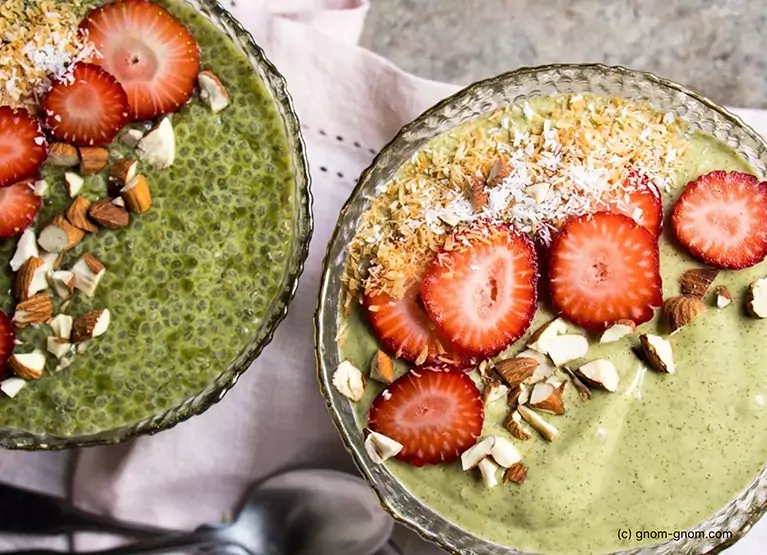Nutritionist-Approved Chia Seed Recipes

Key Takeways
Did you know that chia seeds are considered an ancient superfood and have been consumed by humans for over 5,000 years?
These nutrient-dense seeds originated in Mexico and Guatemala and were used by the Aztecs and Mayans for holistic medicinal uses such as folk medicine and herbal preparations. Nowadays, chia seeds remain a popular ingredient in everything from smoothies to toast.
If you love eating your chia seed pudding but had no idea you’re consuming one of the ancient superfoods of the world, then you’re in for a pleasant surprise. The nutrients in these seeds are even beneficial for your metabolic health.
In this post, we dive into what makes chia seeds so good for you, and even share some chia seed recipes recommended by Nutrisense nutritionist Heather Davis, MS, RDN, LDN.
Types of Chia Seeds
There are two main types of chia seeds: black chia seeds and white chia seeds. Both types are naturally grown varieties.
While they differ in color, there aren’t many differences in the nutritional content of these two different seeds. This means that regardless of which type you choose to consume, you’re still getting similar benefits.
Nutritional Content of Chia Seeds
Not only are chia seeds delicious and can be added to many foods in a variety of ways, they are also nutrient dense. Let’s dig into what makes chia seeds so nutritious.
A half ounce of black chia seeds contains many beneficial nutrients such as:

Antioxidant Content of Chia Seeds
Along with the macro and micronutrients listed above, chia seeds also contain beneficial antioxidants such as:
- Chlorogenic acid, which has potent antioxidant, anti-inflammatory, anti-diabetic, anti-carcinogenic, and even anti-obesity properties.
- Caffeic acid, usually found in most teas and wines, also has strong anti-inflammatory, anti-oxidant, and anti-carcinogenic properties.
- Myricetin’s antioxidant properties help reduce oxidative stress, platelet aggregation, hypertension risk, allergies, and help regulate the immune system.
- Quercetin also has anti-inflammatory properties (like the other antioxidants in this list). Like myricetin, quercetin can also help reduce allergies. It can also potentially protect against cancer and heart disease.
- Kaempferol’s antioxidant properties help fight against free radicals, which can help prevent certain chronic diseases. It also has anti-inflammatory and anti-carcinogenic properties.
It’s important to note, however, that these compounds are still undergoing deeper investigation for their antioxidant effect in the living body.
Many of them have primarily been studied in vitro or cell cultures and more human in vivo studies are necessary to determine the full antioxidant effect in the body.
Best Way to Eat Chia Seeds

If you’re new to eating chia seeds, you may want to introduce a small quantity to your diet to avoid bloating and digestive issues as these seeds are high in fiber. Practice these mindful eating habits to get the most benefits out of these seeds and promote optimal digestion.
- Put away your phone and avoid watching or looking at screens while eating. Instead connect with the scenery outside your window or your immediate environment.
- Practice proper posture by sitting up with your knees level with your hips.
- Engage in belly breathing to activate the rest and digestion branch of your nervous system.
- Take in the food with all your senses before eating.
Once you’ve adjusted to added fiber in your diet, you may find your body better able to digest foods high in fiber and you can start experimenting with healthy recipes with these nutritious seeds.
When it comes to adding them to your diet, sure, you can down a spoonful of chia seeds for the myriad health benefits they offer. But there are lots of fun and delicious ways to consume chia seeds.
Here are a few of our favorites recipes to try out:
4 Healthy Breakfast Ideas with Chia Seeds
1) Coconut Chia Pudding by Nom Nom Paleo

Ingredients
- 1 can full-fat coconut milk (13.5 ounces)
- 2.5 ounces cold water
- 1 teaspoon of honey: optional
- 1 teaspoon vanilla extract
- ½ teaspoon ground cinnamon
- ½ cup chia seeds
- Diced fresh fruit such as strawberries, raspberries, or blueberries
- Toasted coconut flakes
- Toasted nuts
Why We Love This Recipe
This chia seed pudding recipe combines a variety of colorful whole foods together to create a balanced meal. The fats from the coconut milk and the protein and fiber content from the chia seeds can help to balance blood sugar.
The added fresh berries boost antioxidant intake, adding to this meal’s superfood content. For added protein, try adding a scoop of unflavored collagen or protein powder into your chia puddings.
2) Strawberry Banana Chia Seed Smoothie by Jar of Lemons
Ingredients
- Frozen Strawberries
- Fresh Banana
- Chia Seeds
- Dairy-free milk of choice (almond milk is great option but you can also use regular cow’s milk)
Why We Love This Recipe
With a very short prep time, this smoothie is a quick breakfast recipe and packs a punch nutritionally! The fresh fruits and chia seeds themselves are great sources of fiber and other nutrients.
If you can tolerate dairy, you can also opt for a high quality dairy milk. Add more protein to this smoothie to make it more satiating by tossing in a spoonful of Greek yogurt, silken tofu, or a scoop of your favorite protein powder.
3) Avocado Toast with Chia Seeds

Ingredients
- 1 slice seed or wheat bread
- 1/2 avocado lightly mashed with a splash of lemon juice
- 1/4 teaspoon red pepper flakes
- 1/2 teaspoon chia seeds
- Honey to drizzle
Why We Love This Recipe
This easy, healthy snack recipe is another quick meal that you can whip up in under five minutes. It’s also nutrient-dense and full of beneficial dietary fat from the avocado.
To make this toast gluten-free, you can swap with a gluten-free bread of your choice, or try one of our no-bread ideas. To make it blood glucose friendly, you may want to omit the honey and have it alongside a whole food protein source such as a hard boiled egg.
4) Vanilla Chia Pudding by Sweet as Honey
Ingredients
- 3 tablespoons chia seeds
- 1 cup unsweetened vanilla almond milk
- 1 tablespoon monk fruit stevia blend
Why We Love This Recipe
This simple recipe is another delicious take on chia seed pudding and is a great meal prep option. Simply toss the ingredients into a bowl and leave it to absorb for a few hours before enjoying. Try it out for a treat that’s lower in sugar but still satisfies your taste buds.
Three of Heather’s Favorite Chia Seed Recipes
Like the rest of us, our nutritionist, Heather Davis, MS, RDN, LDN, is a lover of chia seeds. She doesn’t just love them for their nutritional profile, but also because of all the creative ways she can use them!
Here are three of Heather’s favorite nutritious and blood sugar-balancing chia seed recipes.
1) Overnight Keto Chia Pudding by Gnom Gnom

Although we’ve already shared two chia seed pudding recipes, this one also deserves to be recognized! Heather loves it because it’s a simple and keto-friendly recipe. Refrigerating this snack overnight helps to thicken it, creating an even tastier texture (similarly to overnight oats).
Ingredients
- 1 cup plant-based (dairy-free) milk such as coconut, macadamia, or almond milk
- 2 tablespoons of chia seeds
- Vanilla stevia drops or preferred sweetener, to taste
- Toppings of choice (you can go for berries, coconut flakes, granola, or nut butter like peanut butter)
2) Power Butter Spread by Bon Appetit
Another delicious and brain-healthy option, this chia seed recipe includes coconut oil. Feel free to omit the maple syrup if you'd like a lower carb option!
Ingredients
- 7 tablespoons virgin coconut oil
- ½ cup raw pumpkin seeds (pepitas)
- ⅓ cup raw sesame seeds
- 3 tablespoons chia seeds
- 1½ cups unsweetened natural almond butter
- 1 teaspoon pure maple syrup
- 1 teaspoon kosher salt
- 1 teaspoon Aleppo-style pepper
3) Low Carb Nut and Seed Crackers by Kay Nutrition

This recipe is another great low carb option for those on the keto diet (or anyone who feels better with low carb consumption). It’s also full of gut supporting and blood sugar-balancing fiber.
Ingredients
- 1 cup almond flour
- 1/2 cup sunflower seeds
- 1/2 cup sesame seeds
- 1/2 cup chia seeds
- 1/4 cup flax seeds
- 1/4 cup pumpkin seeds
- 2 tablespoons fresh rosemary, minced
- 1/2 teaspoon onion powder
- 1/2 teaspoon garlic powder
- 1/2 teaspoon sea salt, plus more for seasoning
- 1 tablespoon olive oil
- 1 cup water
Find the right Nutrisense programto turn insight into progress.
Go Beyond Glucose Data with Nutrisense
Your glucose can significantly impact how your body feels and functions. That’s why stable levels are an important factor in supporting overall wellbeing. But viewing glucose isn't enough. Nutrisense, you’ll be able to learn how to use your body's data to make informed lifestyle choices that support healthy living.
One-to-one coaching
Sign up to access insurance-covered video calls to work with a glucose expert: a personal registered dietitian or certified nutritionist who will help tailor your lifestyle and diet to your goals.
Monitor and measure what matters
With the Nutrisense CGM Program, you can monitor your glucose with health tech like glucose biosensors and continuous glucose monitor (CGM)s, and analyze the trends over time with the Nutrisense App. This will help you make the most informed choices about the foods you consume and their impact on your health.
Find your best fit
Ready to take the first step? Start with our quiz to find the right Nutrisense program to help you take control.

Heather is a Registered and Licensed Dietitian Nutritionist (RDN, LDN), subject matter expert, and technical writer, with a master's degree in nutrition science from Bastyr University. She has a specialty in neuroendocrinology and has been working in the field of nutrition—including nutrition research, education, medical writing, and clinical integrative and functional nutrition—for over 15 years.




